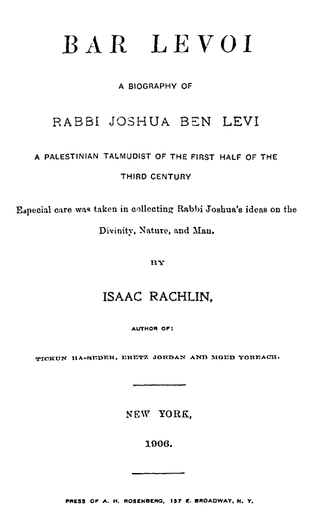Related Research Articles
Rav Abba bar Aybo, commonly known as Abba Arikha or simply as Rav (רַב), was a Jewish amora of the 3rd century. He was born and lived in Kafri, Asoristan, in the Sasanian Empire.
Judah ha-Nasi or Judah I, known simply as Rebbi or Rabbi, was a second-century rabbi and chief redactor and editor of the Mishnah. He lived from approximately 135 to 217 CE. He was a key leader of the Jewish community in Roman-occupied Judea after the Bar Kokhba revolt.

Akiva ben Joseph, also known as Rabbi Akiva, was a leading Jewish scholar and sage, a tanna of the latter part of the first century and the beginning of the second century. Rabbi Akiva was a leading contributor to the Mishnah and to Midrash halakha. He is referred to in the Talmud as Rosh la-Hakhamim -"Chief of the Sages". He was executed by the Romans in the aftermath of the Bar Kokhba revolt.

Shimon bar Yochai or Shimon ben Yochai, also known by the acronym Rashbi, was a 2nd-century tannaitic sage in ancient Judea. He was one of the most eminent disciples of Rabbi Akiva. The Zohar, a 13th century foundational work of Kabbalah, is ascribed to him by Kabbalistic tradition.
Johanan bar Nappaha was a leading rabbi in the early era of the Talmud. He belonged to the second generation of amoraim.
Rabbah bar Naḥmani was a Jewish Talmudist known throughout the Talmud simply as Rabbah. He was a third-generation amora who lived in Sassanian Babylonia.
Abba ben Joseph bar Ḥama, who is exclusively referred to in the Talmud by the name Rava, was a Babylonian rabbi who belonged to the fourth generation of amoraim. He is known for his debates with Abaye, and is one of the most often cited rabbis in the Talmud.
Jose ben Halafta or Yose ben Halafta was a tanna of the fourth generation. He is the fifth-most-frequently mentioned sage in the Mishnah. Of the many Rabbi Yose's in the Talmud, Yose Ben Halafta is the one who is simply referred to as Rabbi Yose.
Adda bar Ahavah or Adda bar Ahabah is the name of two Jewish rabbis and Talmudic scholars, known as Amoraim, who lived in Lower Mesopotamia, a region known in Jewish texts as "Babylonia".
Rabbi Ammi, Aimi, Immi is the name of several Jewish Talmudists, known as amoraim, who lived in the Land of Israel and Babylonia. In the Babylonian Talmud the first form only is used; in the Jerusalem Talmud all three forms appear, Immi predominating, and sometimes R. Ammi is contracted into "Rabmi" or "Rabbammi".

Joshua ben Levi was an amora, a scholar of the Talmud, who lived in the Land of Israel in the first half of the third century. He lived and taught in the city of Lod. He was an elder contemporary of Johanan bar Nappaha and Resh Lakish, who presided over the school in Tiberias. With Johanan bar Nappaha, he often engaged in homiletic exegetical discussions.
Eliezer ben Hurcanus or Hyrcanus was one of the most prominent Sages (tannaim) of the 1st and 2nd centuries in Judea, disciple of Rabban Yohanan ben Zakkai and colleague of Gamaliel II, and of Joshua ben Hananiah. He is the sixth most frequently mentioned sage in the Mishnah.
Levi II, or Rabbi Levi was a Jewish scholar of the 3rd century. In a few cases he is quoted as Levi bar Laḥma (Hama). In later midrashim the title "Berabbi" is sometimes added to his name.
Rabbah bar bar Hana was a Jewish Talmudist who lived in Babylonia, known as an Amora of the second generation.
Forbidden relationships in Judaism are intimate relationships which are forbidden by prohibitions in the Torah or rabbinical injunctions.

A law given to Moses at Sinai refers to a halakhic law for which there is no biblical reference or source, but rather was passed down orally as a teaching originating from Moses at Sinai. Such teachings have not been derived from any Talmudical hermeneutics, but known solely from the Jewish tradition.
Rabbi Isaac Nappaha, or Isaac the smith, was a rabbi of the 3rd-4th centuries who lived in the Galilee.

Jewish law and custom prescribe ritual hand washing in a number of situations. This practice is generally known by the Hebrew term נטילת ידיים, which literally means taking up of the hands.
Rabbi Simeon ben Jehozadak was a rabbi who was one of the semi-tannaim on the border between the eras of tannaim and amoraim.

Ḥanan bar Rava or Ḥanan bar Abba was a Talmudic sage and second-generation Babylonian Amora. He lived in Israel, moved to Babylonia with Abba b. Aybo, and died there ca. 290 CE. He is distinct from the late-generation Babylonian Amora of the same name who apparently conversed with Ashi.
References
- ↑ "Jerusalem Talmud Berakhot 2:4:9". www.sefaria.org. Retrieved 2024-04-10.
- 1 2 Midrash Tanchuma Naso 4; Tanchuma Beshalach 27
- 1 2 "Bava Kamma 55a". www.sefaria.org. Retrieved 2024-04-10.
- ↑ Sukkah 54a, Yevamot 57a and Yevamot 58a, Sota 24b and Chullin 132b
- ↑ "Jerusalem Talmud Berakhot 2:4:9". www.sefaria.org. Retrieved 2024-04-10.
- ↑ "Berakhot 5a". www.sefaria.org. Retrieved 2024-04-10.
- ↑ "Shabbat 114a". www.sefaria.org. Retrieved 2024-04-10.
- ↑ "Sotah 49a". www.sefaria.org. Retrieved 2024-04-10.
- ↑ "Sanhedrin 81a". www.sefaria.org. Retrieved 2024-04-10.
- ↑ Sanhedrin 47a
- ↑ "Jerusalem Talmud Berakhot 3:4". www.sefaria.org. Retrieved 2024-04-10.
- ↑ "Jerusalem Talmud Sukkah 5:8". www.sefaria.org. Retrieved 2024-04-10.
- ↑ "Berakhot 8a". www.sefaria.org. Retrieved 2024-04-10.
- ↑ "Berakhot 51b". www.sefaria.org. Retrieved 2024-04-10.
- ↑ "Sanhedrin 47a". www.sefaria.org. Retrieved 2024-04-10.
- ↑ "Horayot 13a". www.sefaria.org. Retrieved 2024-04-10.
- ↑ "Shabbat 55a". www.sefaria.org. Retrieved 2024-04-10.
- ↑ "Eruvin 64a". www.sefaria.org. Retrieved 2024-04-10.
- ↑ "Nedarim 39b". www.sefaria.org. Retrieved 2024-04-10.
- ↑ "Pesachim 50a". www.sefaria.org. Retrieved 2024-04-10.